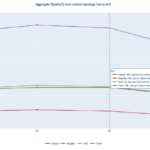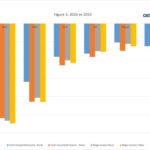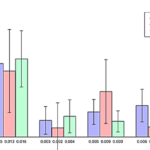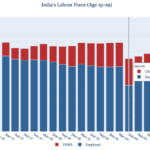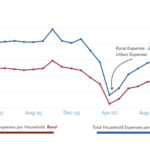True Impact of Lockdown on Employment
1. Introduction
The Covid outbreak appeared as a national crisis towards the middle of March 2020. To counter the spread of the Covid infection, the government ordered a nationwide lockdown from 24th March 2020. Economic activities resumed from the first week of June with restrictions on activities and movement continuing in many sectors and areas. We do not have direct official estimates of employment and income loss due to the lockdown. Recently the National Statistical Office (NSO) has published the results of the Periodic Labour Force Survey (PLFS) covering the period July 2019 to June 2020. The last two quarters of this round cover the first phase of the lockdown and help throw some light on its impact on employment and earnings. In this study we estimate the employment related indicators using the PLFS data to understand the extent of change in employment during the first lockdown.
The lockdown was sudden, and was specifically intended to restrict movement and gathering of people. Thus, it curtailed activities of large sections of the workforce. The conventional one-dimensional indicators fail to reveal the nature of the job losses during the lockdown. In this research note, we suggest more appropriate indicators and estimate them from the survey data. We examine the quarter-wise estimates specifically focussing on the last two quarters of the survey using the daily activity status data.
2. Employment surveys and indicators
Prior to the present PLFS, NSO used to have quinquennial surveys on employment and unemployment (EUS). The first such survey was conducted during 1972-73 and the last was in 2011-12. After a gap of six years, the NSO came up with the PLFS from 2017-18. In the PLFS rural households in the sample are visited only once while those in the urban areas form a panel and are revisited in the following three quarters with one-fourth of the households replaced every quarter with new households. The main PLFS report published annually is based only on the data collected from the first visit for both rural and urban areas. The other type of reports – the quarterly reports – consist of urban employment indicators derived using the data from the first visit for the newly added households and the data from the re-visits to the others. However, in this paper we use only the first visit data for urban areas.
Measuring Employment: EUS and PLFS
The annual survey collects data almost identical to the EUS using the same concepts and procedure. The activity status of the respondent is reported using the usual status approach with a reference period of one year and the current daily status (CDS) are recorded for all the seven days preceding the date of survey. The current weekly status (CWS) is derived from the seven days’ recording of daily status. The shorter reference period of one week is usually adopted internationally. In this method any engagement in work during the week is sufficient to categorise the respondent as a worker. The daily record of work and non-work activities for each day of the week used in Indian surveys is a superior innovation, from which the CWS can be identified using a major time spent criteria when multiple activities are pursued during the week. As usual, particulars of a maximum of two different economic activities of those in the labour force are recorded for each day.
The usual status with a long reference period has certain limitations in reflecting the current situation, compared to the CWS and CDS. The Centre for Monitoring Indian Economy (CMIE), that has been providing high frequency indicators for employment-unemployment from their Consumer Pyramid Household Survey (CPHS), uses a one-day reference period. But, the CWS and CDS estimates of the PLFS, being based on short reference period of 7 days, is likely to reflect the current situation better. Unlike in the past when these estimates did not show much change in the employment-unemployment situation, recent unexpected and large shocks such as demonetization in 2016 or the 2020 lockdowns are capable of drastically impacting them.
The two key indicators we use for the discussions are the Work Participation Rate (WPR) and the Unemployment Rate (UR). Work Participation Rate (WPR) is the percentage of workers in the population for a given age group. The Unemployment Rate (UR) is the percentage of unemployed in the labour force where the labour force is the sum of those working and those seeking work (the unemployed). In fact, UR represents the unutilised portion of the labour force, which in a country like India is determined by a host of economic and non-economic factors.
Employment by Daily Status: Person or Person-days?
For our analysis of the PLFS data we use the Principal Usual Status, CWS and the CDS. Instead of using a single day’s observation to derive CDS indicators as in surveys like the CPHS, we use the information of daily status for all seven days recorded in the survey schedule. However, we make a departure by using the CDS as a person measure instead of as a person-day measure as is usually done in the EUS reports.
The estimates based on CDS have generally been expressed in person-days. The recording of statuses for seven days with the option to record two different activities a day can capture the context better where the employment-unemployment status of a person is a continuum rather than a mutually exclusive condition. Instead of expressing the estimates in terms of person-days of employment or unemployment, we express the estimates as fractions of employment or unemployment based on the seven days statuses. This means a person reporting employment on all days is counted as one employed person while those reporting unemployment or other non-work activity status on some days are counted as less than one. As against this, in the CWS, one work activity on any of the days in the week classifies the person as a worker.
Both CWS and CDS provide some additional information on work status not relevant for the usual status. Apart from identifying workers by the type of work like self-employment, casual work and regular wage/salaried with additional sub-categories within these, the workers who had work but were absent either due to sickness or for ‘other reasons’ are given separate status codes to reflect the actual status on the reporting days. In a lockdown situation where workers are involuntarily kept away from work though they have work/job – as it happens for self-employed and regular workers – it is important to separate them from the actual workers for estimating work participation rates. Excluding them gives us the actual WPR against the potential WPR, as the temporary closure of the enterprises is likely to be a dominant component of ‘other reasons’ during lockdowns. To distinguish these indicators from the conventional WPR and UR, we call this the ‘actual WPR’ and the corresponding UR as the ‘actual UR’. In this process, the conventional labour force definition gets modified to the extent that persons who are unable to work, get excluded from the labour force, unless they report as unemployed. Consequently, the denominator used for deriving unemployment rate would be smaller.
3. Employment and unemployment in different quarters of 2019-20
Using the unit level data of PLFS 2019-20, we estimate the WPR and UR for the 15+ population for each quarter. As noted above, by excluding persons not working for ‘other reasons’, we estimate the actual WPR and the corresponding actual UR. These are presented in Table 1, separately for men and women in rural and urban areas. The number ‘actually working’ does not include those having a regular wage/salaried job or in self-employment but did not work due to sickness or other reasons. The conventional estimates of WPR and UR are also given to indicate the magnitude of the impact of lockdown on these indicators.
The official report of the survey presents the conventional estimate of the WPR and UR and most of the commentators have used these indicators. Predictably the first two quarters of the survey show only small changes in the actual WPR and actual UR from the usual measures. This is because though on any given day a certain number of self-employed and regular salaried workers stay away from work for various reasons, these numbers are generally small.
The virus spread appeared around the middle of March bringing in gradual restrictions on movements. Complete lockdown happened after the third week of March. We do find a slowing of economic activities during the January-March quarter with WPR declining, especially if we exclude those usual workers currently absent from work. The actual WPR for the last quarter of the survey (April to June) shows the enormity of impact of the lockdown on economic activity. Actual WPR declined by around 12 percentage points (amounting to 19 percent fall in actual workforce) from the October-December level for rural men and 24 percentage points (39 percent fall in actual workforce) for urban men. For women the corresponding fall in actual workforce are 22 percent and 43 percent.
Table 1: Employment-unemployment indicators based on daily status recordings
| population group | CDS based indicators in percent | Q1 (July-Sep 2019) | Q2 (Oct-Dec 2019) | Q3 (Jan-Mar 2020) | Q4 (Apr-Jun 2020) |
|---|---|---|---|---|---|
| Rural Men | WPR | 67.5 | 68.4 | 67.5 | 63.0 |
| UR | 10.9 | 10.5 | 11.4 | 16.8 | |
| actual WPR | 64.3 | 65.1 | 62.3 | 52.9 | |
| actual UR | 11.3 | 11.0 | 12.3 | 19.4 | |
| Rural Women |
WPR | 25.0 | 26.3 | 25.1 | 22.1 |
| UR | 9.0 | 7.4 | 9.3 | 11.7 | |
| actual WPR | 23.9 | 25.1 | 23.6 | 19.6 | |
| actual UR | 9.3 | 7.7 | 9.9 | 13.0 | |
| Urban Men | WPR | 66.8 | 66.3 | 65.3 | 57.8 |
| UR | 10.5 | 9.7 | 11.7 | 19.7 | |
| actual WPR | 60.8 | 60.0 | 57.4 | 36.4 | |
| actual UR | 11.4 | 10.6 | 13.1 | 27.9 | |
| Urban Women | WPR | 20.1 | 19.4 | 20.1 | 15.6 |
| UR | 11.3 | 11.2 | 12.3 | 22.2 | |
| actual WPR | 18.1 | 17.4 | 17.7 | 10.0 | |
| actual UR | 12.4 | 12.3 | 13.8 | 30.9 |
As mentioned, for the actual unemployment rates we exclude the workers who are absent from work due to ‘sickness’ and ‘reasons other than sickness’ from the workforce. The actual unemployment rates doubled during April-June quarter compared to the January-March quarter in the urban areas showing that the lockdown impact was much more severe in urban areas compared to rural areas where the rates rose by around 50 percent. While the work participation went down, the unemployment remained, resulting in a big jump in the unemployment rate for all categories.
What does this mean in terms of number of persons? Using the population projections for the mid points of the four quarters and the rates reported in Table 1, we estimate the number of actually working as also the not working (Table 2). The PLFS had indicated an improvement in the employment situation during the October-December 2019 period. This is clearly shown in the lower number of unemployed and the small increase in the number of employed.
The people actually found working during the survey period fell from 419 million in October-December to 312 million in the quarter starting April 2020, which closely corresponds to the first lockdown. This is a reduction of 107.3 million workers. Roughly half of these were persons who had work in their own establishments or had a regular job but could not work. Hopefully some of these would have regained their employment after the restrictions were eased. Even if that happened subsequently, such a large-scale reduction in work will have long term effect on the country’s employment scenario, since many of the smaller establishments will find it hard to recover after scaling down their operations. The number of persons looking or available for work rose from 48.5 million to 82 million during this period. We should note that the UR using the daily status is higher than UR based on usual status or even the weekly status.
Table 2: Estimated number (million) in labour force according to CDS by actual activity status– Rural and Urban combined
| Quarter | actually working | not working self-employed workers | not working regular salaried/wage workers | unemployed |
|---|---|---|---|---|
| Jul-Sept 2019 | 414.17 | 14.00 | 13.41 | 51.64 |
| Oct-Dec 2019 | 419.34 | 14.26 | 14.23 | 48.55 |
| Jan-Mar 2020 | 402.75 | 21.75 | 17.06 | 55.73 |
| Apr-Jun 2020 | 311.99 | 47.60 | 38.83 | 82.00 |
4. Job Losses by Type of Employment
The workforce reported in Table 1 comprises of self-employed, regular salaried and casual workers. The break-up of the WPR under each of these categories is shown in Table 3. It is expected that lockdown restrictions would affect all categories except for those employed in government, health and other essential services. Looking at the indicators for fourth quarter with those of other quarters, we find the only category that was not significantly affected are the self-employed rural men. Majority of the self-employed in rural areas work in agriculture and allied activities and these categories were not much affected by movement restrictions. The self-employed fared badly in urban areas. In the case of casual workers, the question of having a job but not working did not arise during the lockdown. Casual employment was severely curtailed in urban areas, and to an extent in rural areas as well. Quite clearly, the lockdown reduced the work participation for all types of workers. We will examine the impact on regular salaried in some more detail later.
The daily status data permits us to estimate the days in employment for each person and this can be used in conjunction with the projected population to estimate the number of days in employment in different quarters. Similarly, one can work out the average number of person-hours of work in a day for the four quarters from the hours of work information collected in the survey.
The Q1 (Jul-Sep 2019) and Q2 (Oct-Dec 2019) estimates of person-days employed cover the pre-pandemic period. In normal course, we would expect the next two quarters to be similar to the average of the first two quarters. Using this, we obtain the percentage of person-days lost in Q3 and Q4 as the difference between the expected and estimated number of person-days, where the expected person-days is worked out as the average of Q1 and Q2 estimates. We apply the average of the days-population ratios for the Q1 and Q2 to the projected mid-quarter 15+ population to obtain the expected number of person-days. The loss in person-days are given in the last two columns of Table 3. Since those not working due to sickness or other reasons are excluded from the estimates of all the four quarters, the estimate of loss takes into account of sickness as well. Since the proportion of sick is unchanged, our estimate of loss in employment reflects the loss due to lockdown.
5. Gender differences in Employment Losses
Activity restrictions are expected to affect women much more than men for a variety of reasons. For one, a large proportion of women’s employment is in the unorganised sector which offers poor job protection. Those in some specific services were differentially impacted by the restrictions. Women find it harder to reach workplaces when there are transport disruptions. The overall loss in person-days in the last quarter of the survey corroborates this. The person-days lost is as high as 43 percent in the urban areas, while it is around 20 percent in rural areas. The lockdown is spread among all types of employment in urban areas.
Table 3: Decomposing the actual workforce in population by broad activity status using CDS and the loss in person-days in the last two quarters
| Population group | Type of workers (in percent) | Q1 (Jul-Sep 2019) | Q2 (Oct-Dec 2019) | Q3 (Jan-Mar 2020) | Q4 (Apr-Jun 2020) | Loss of person-days (in percent) | |
|---|---|---|---|---|---|---|---|
| Q3 | Q4 | ||||||
| Rural Men | self-employed | 39.7 | 39.9 | 38.3 | 35.3 | -3.6 | -9.8 |
| regular workers | 9.0 | 8.9 | 9.1 | 5.9 | 1.8 | -34.1 | |
| casual workers | 15.6 | 16.3 | 14.9 | 11.7 | -6.6 | -25.0 | |
| actually working | 64.3 | 65.1 | 62.3 | 52.9 | -3.6 | -17.0 | |
| Rural Women | self-employed | 15.4 | 15.9 | 15.8 | 13.5 | 0.6 | -15.2 |
| regular workers | 2.7 | 2.8 | 2.3 | 1.6 | -14.5 | -36.9 | |
| casual workers | 5.7 | 6.4 | 5.5 | 4.5 | -9.8 | -24.1 | |
| actually working | 23.9 | 25.1 | 23.6 | 19.6 | -3.6 | -19.7 | |
| Urban Men | self-employed | 25.1 | 23.7 | 23.0 | 15.2 | -5.8 | -34.7 |
| regular workers | 28.6 | 29.4 | 28.1 | 17.6 | -3.2 | -38.8 | |
| casual workers | 7.1 | 6.9 | 6.3 | 3.6 | -9.6 | -45.8 | |
| actually working | 60.8 | 60.0 | 57.4 | 36.4 | -5.0 | -38.0 | |
| Urban Women | self-employed | 6.1 | 6.2 | 6.4 | 3.6 | 3.9 | -42.5 |
| regular workers | 10.5 | 9.9 | 9.8 | 5.5 | -3.9 | -44.0 | |
| casual workers | 1.5 | 1.2 | 1.5 | 0.8 | 8.3 | -38.4 | |
| actually working | 18.1 | 17.4 | 17.7 | 10.0 | -0.3 | -43.0 | |
Note: The loss person-days is estimated relative to the average of Q1 and Q2
6. Loss of working hours in broad industry sectors
The lockdown had a differential impact on different sectors. Here we provide estimates for only the broad industry sectors, using the detailed economic activity classes included in the survey data. The CDS considers either a full day or a half-day for each activity. We derive industry distribution of CDS giving equal weightage to different activities. As the survey data provides hours worked in the day for each activity, we use the estimate of average number of hours worked in different quarters as a better indicator to assess the sectoral impact. These are given in Table 4.
In the rural areas, the agriculture sector remained unaffected with work participation remaining close to its normal levels, given its seasonal fluctuations. This sector has reported the hours worked with only a small decrease in Q4, which could arise from reduction in casual labour employed in agriculture. Participation rates in all other industry groups fell in Q4.
Work participation for most sectors in urban areas got reduced by as much as half due to the lockdown restrictions. In Table 4, the construction sector alone has somewhat bucked the trend in Q3 and also in Q4 for rural women. One reason for this could be the increased number of persons days of employment provided under the National Rural Employment Guarantee Scheme (MGNREGS). The person-days of employment provided under this scheme shows an increase in Q3 and Q4, possibly the latter part of Q4. In the case of trade, the loss of hours is much higher especially for women, who are possibly engaged in trading without a fixed location that could be more affected than others. There were even restrictions on the hours for opening of retail shops selling essential items during this period. The category of activities under ‘domestic services’ includes all services provided by personnel hired by the households, such as domestic helps, cooks, gardeners and drivers. These categories of workers were kept away from work as a part of social distancing advised by the authorities.
Table 4: Estimated average number of hours (mill.) of work per day by broad industry for each quarter
| Population group | Broad industry | Hours of work (in million) | Percentage gain/loss (-) | ||||
|---|---|---|---|---|---|---|---|
| Q1 | Q2 | Q3 | Q4 | Q3 | Q4 | ||
| Rural Men | Agriculture & allied sectors | 842.9 | 826.9 | 758.9 | 716.7 | -9.27 | -9.78 |
| Industry | 137.9 | 125.4 | 150.1 | 89.2 | 13.76 | -35.38 | |
| Construction | 212.0 | 225.5 | 222.2 | 169.5 | 1.37 | -24.43 | |
| Trade | 22.7 | 28.1 | 26.3 | 14.0 | 3.28 | -48.58 | |
| Services (non-domestic) | 366.1 | 395.2 | 359.1 | 245.9 | -5.84 | -34.91 | |
| Domestic services | 3.9 | 4.6 | 2.3 | 1.5 | -46.73 | -57.57 | |
| all | 1585.5 | 1605.7 | 1518.8 | 1236.8 | -4.99 | -20.98 | |
| Rural Women | Agriculture & allied sectors | 347.8 | 370.6 | 327.5 | 285.4 | -9.03 | -18.43 |
| Industry | 39.9 | 43.7 | 39.8 | 22.4 | -5.04 | -46.55 | |
| Construction | 13.7 | 19.3 | 24.4 | 27.6 | 47.77 | 26.01 | |
| Trade | 1.5 | 0.6 | 0.9 | 0.2 | -18.50 | -66.39 | |
| Services (non-domestic) | 70.1 | 62.1 | 67.0 | 44.0 | 1.18 | -31.95 | |
| Domestic services | 3.4 | 4.1 | 3.4 | 2.1 | -8.56 | -42.86 | |
| all | 476.4 | 500.3 | 463.0 | 381.7 | -5.41 | -20.93 | |
| Urban Men | Agriculture & allied sectors | 35.5 | 35.7 | 31.0 | 35.8 | -13.51 | 6.36 |
| Industry | 202.6 | 221.3 | 190.5 | 105.5 | -10.81 | -49.17 | |
| Construction | 85.8 | 87.9 | 89.9 | 49.6 | 2.69 | -44.56 | |
| Trade | 48.0 | 54.1 | 45.8 | 24.1 | -10.94 | -52.05 | |
| Services (non-domestic) | 489.5 | 457.0 | 462.1 | 282.1 | -3.10 | -39.08 | |
| Domestic services | 12.5 | 14.7 | 11.8 | 5.4 | -14.06 | -59.76 | |
| all | 873.9 | 870.6 | 831.1 | 503.9 | -5.45 | -41.39 | |
| Urban Women | Agriculture & allied sectors | 13.4 | 10.2 | 11.9 | 10.8 | -0.06 | -3.49 |
| Industry | 49.0 | 44.0 | 36.8 | 23.3 | -21.36 | -42.87 | |
| Construction | 6.8 | 7.0 | 9.4 | 4.0 | 36.03 | -51.21 | |
| Trade | 3.4 | 2.5 | 3.0 | 0.9 | 0.53 | -68.00 | |
| Services (non-domestic) | 110.2 | 106.8 | 116.7 | 59.3 | 6.72 | -47.30 | |
| Domestic services | 20.6 | 18.8 | 20.7 | 9.7 | 4.26 | -51.46 | |
| all | 203.3 | 189.3 | 198.5 | 109.3 | 0.35 | -44.76 | |
7. Impact of lockdown on regular salaried/wage workers
Generally, it is assumed that the regular salaried employment provides more secure working conditions. As we noted in Table 1, a sizable part of regular workers was actually not working due to the lockdown restrictions and possible closure of their establishments during this period. The regular salaried could be working either in the private corporate sector or in the non-corporate sector encompassing all the unorganised sector establishments i.e. proprietorship or partnership firms.
About a fourth of the Indian workforce work as regular wage/salaried employees. The share of this group of workers in the urban workforce exceeds 50 percent and that in the rural workforce is about 13 percent. The regular wage/salaried or the regular jobs are generally more remunerative than casual jobs, but the compensations they receive vary widely depending upon the type of enterprises they work for. Those employed in the unorganised sector enterprises, such as local grocery, transporters, artisans etc receive much less than those employed in the organised sector enterprises. The latter group of regular employees supposedly enjoys greater job security than the former during normal times. Thus, it is important to separately assess the effect of lockdown on the livelihood and earnings of these two groups of regular workers. This is done by looking at the quarterly estimates of current-status employment and earnings of those who report their principal usual status as regular salaried worker in non-agricultural establishments. It is to be noted that those engaged in animal husbandry and fishing are, however, included in the coverage of these estimates.
First, we address the question “how much regular job loss happened in the non-agricultural sector in the fourth quarter due to lockdown?” The enterprises providing regular jobs are divided into two categories – private unincorporated proprietorships & partnerships and private corporate enterprises. The latter excludes the government & public sector, trusts and cooperatives. Normally, about two-thirds of them work in urban areas, where the effects of lockdown were much more severe than in rural areas. Close to a half of these urban workers are engaged by the corporate sector.
We look at how many of those reporting regular jobs as their principal usual activity were ‘actually working’ in their jobs and those reporting unemployment and out of labour force as their current daily status. These percentages are given in Table 5 separately for rural and urban and enterprise types for all the four quarters.
During Q1 and Q2, when the virus was unheard of, a small percentage (2 to 3 percent) of the regular workers reported to be either currently unemployed or out-of-labour. This is possible since we are considering the current status of usually employed regular workers. The percentage of such persons increased considerably during Q4 for all types of employer-enterprises. As expected, the proportion of jobs lost in rural areas as a whole was of a relatively smaller order, but among those engaged by the corporate sector, it was of the same order as in urban areas. Mostly the rural regular workers reporting corporate sector jobs work in urban locations. Over 10 percent of the regular workers living in urban and rural areas and employed by the corporate sector reported unemployment in Q4. Reporting unemployment can happen when the workers lose their jobs and not actually expect to return to work after the restrictions. The estimates suggest that, in spite of labour protection offered by formal enterprises, they also suffered loss of jobs.
Table 5: Percentage of usually employed regular workers (principal activity) ‘actually working’, reporting unemployment and being out of labour force as per their current daily status
| Enterprise type and location | Activity status by CDS | Percentage of usually employed regular workers | |||
|---|---|---|---|---|---|
| Q1 | Q2 | Q3 | Q4 | ||
| Rural unincorporated | ‘Actually working’ as regular workers | 84.8 | 87.8 | 83.3 | 52.6 |
| Reporting unemployed | 1.7 | 0.7 | 1.8 | 5.5 | |
| Reporting out of labour force | 0.3 | 0.2 | 0.8 | 2.1 | |
| Rural Corporate | ‘Actually working’ as regular workers | 88.0 | 84.3 | 83.2 | 55.5 |
| Reporting unemployed | 1.4 | 1.8 | 2.8 | 11.3 | |
| Reporting out of labour force | 0.7 | 0.5 | 0.4 | 1.4 | |
| Urban unincorporated | ‘Actually working’ as regular workers | 88.1 | 87.3 | 84.7 | 47.0 |
| Reporting unemployed | 1.1 | 1.0 | 1.0 | 8.9 | |
| Reporting out of labour force | 0.4 | 0.9 | 1.4 | 3.1 | |
| Urban Corporate | ‘Actually working’ as regular workers | 84.9 | 83.7 | 81.3 | 50.6 |
| Reporting unemployed | 0.6 | 1.6 | 1.4 | 10.2 | |
| Reporting out of labour force | 0.6 | 0.7 | 1.3 | 3.4 | |
8. Concluding remarks
Before the pandemic, disruptions in economic activity due to natural calamities or other events typically lasted for a short duration, often confined to a small area and therefore, economic activity could be restored quickly. The Covid control measures were applied nationally and the impact was large as virtually all economic activity stopped due to the lockdown. The economic impact could thus be studied from the perspective of labour force changes and earnings from employment.
The data from the PLFS conducted by the NSO during 2019-20 covered the first phase of the nationally enforced lockdown. We make a departure from the conventional WPR and UR indicators by estimating the actual WPR and actual UR by excluding persons who could not work due to the lockdown, even when their jobs notionally existed.
Analysis of the data separately for the four quarters bring out the stark negative effect of the lockdown on employment. Except for the agricultural sector employing mostly rural men, most other sectors saw drastic fall in employment. The number of actually working individuals came down by as much as 107.3 million in the last quarter from a high of 419.3 million in the second quarter of the survey. The persons reporting unemployment in Q4 rose to 82 million compared to 48.5 million in Q2
Note: This is a part of a larger study on the impact of lockdown on employment and earnings
Aloke Kar (alokekar@gmail.com) is currently Visiting Scientist, Indian Statistical Institute, Kolkata.
P C Mohanan (parachottilmohanan@gmail.com) is a former member of the National Statistical Commission.
References
- July 2021, Government Of India, National Statistical office, Annual Report Periodic Labour Force Survey (PLFS) July 2019-June 2020
- Can Conventional Metrics of Employment be Accurate During a Lockdown?’ P C Mohanan, Aloke Kar, The India Forum, October 2, 2020
- Periodic Labour Force Survey 2019-20: What does it tell us? Centre for Economic Data and Analysis, Ashoka University, 12th August 2021
- National Commission on Population (2019). Population Projections for India and States 2011 – 2036. Ministry of Health & Family Welfare
If you wish to republish this article or use an extract or chart, please read CEDA’s republishing guidelines.




